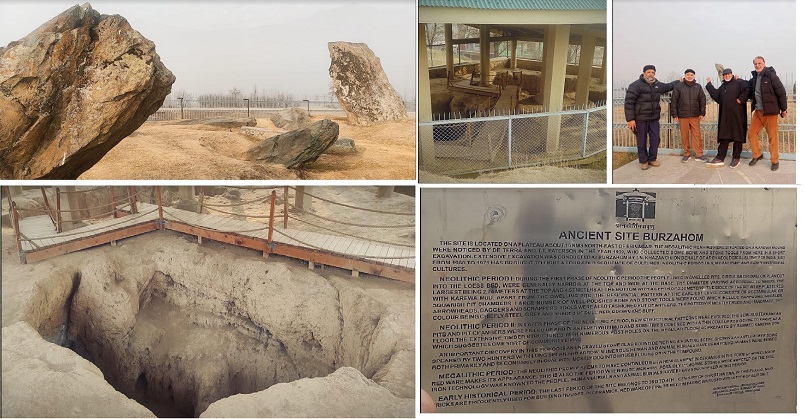
Had a quick visit to Burzahom today with some old friends and former colleagues. Located on a plateau 16 kms north-east of Srinagar, Burzahom is a Neolithic site noticed by De Terra and T T Paterson in 1939. Extensive excavation was conducted from 1960 to 1971 by the Archaeological Survey of India which brought to light four-fold sequence of cultures: Neolithic period I and II, Megalithic and Early Historical Cultures. The Burzahom threw up the thus far known first human settlements in Kashmir that relate to 5,000 years before the present. It is a comprehensive story of cultural sequence in Kashmir between 3000 BC and 1000BC. In a short excavation in 1939, De Terra and Paterson collected some bone and stone tools from here. Subsequent exploration by the ASI brought to light about a dozen similar sites such as Begagund, Brah, Gofkral, Hariparigom, Jayadevi-udar, Olichibag, Pampur, Panzogom, Sombur, Thajiwor and Waztal, all located on karewas, especially in the southeast parts of the Kashmir Valley. The importance of Burzahom can be appreciated by the following UNESCO reference about the site: “The core aspects of the Burzahom Neolithic seem to have originated and organically evolved on the soil of Kashmir, and bear an exceptional testimony to a cultural tradition which has now largely disappeared. The nominated property with its entire cultural equipment range has potential for future excavation and other avenues of research which is surely ripe with new set of information throwing a welcome light on the formative stages of culture and civilization in this part of the world. Sometime at the turn of the fourth millennium BCE, the Neolithic Burzahom appears to the major centres of prehistoric man’s activity in Kashmir. The detailed study of the material culture, palaeo-climate, flora, and fauna, micro-wear studies, and other multidisciplinary studies has provided an opportunity to understand and analyse the interaction of the Neolithic population of Burzahom with the Himalayan hinterland and the riverine sites of West Asia…. The entire site retains its physical integrity and is still set in a landscape that is reminiscent to the natural setting of the Neolithic men approximately in 4th millennium BC.” The core aspects of the Burzahom Neolithic seem to have originated and organically evolved on the soil of Kashmir and bear an exceptional testimony to a cultural tradition which has now largely disappeared. Importantly, no religious images or icons giving any idea about the religious beliefs of the dwellers have been found at these sites: “In different places of the world, we find an image or an icon worshipped by people of that area at one point in time. In Burzahom we have found no such icon or image.” However, what we know for sure from the findings there is that the Neolithic man in Kashmir buried his dead in carefully dug graves, in some cases alongside their domesticated animals.
- The write up was originally a Facebook post and is being reproduced here with the author’s permission
Follow this link to join our WhatsApp group: Join Now
Be Part of Quality Journalism |
Quality journalism takes a lot of time, money and hard work to produce and despite all the hardships we still do it. Our reporters and editors are working overtime in Kashmir and beyond to cover what you care about, break big stories, and expose injustices that can change lives. Today more people are reading Kashmir Observer than ever, but only a handful are paying while advertising revenues are falling fast. |
| ACT NOW |
| MONTHLY | Rs 100 | |
| YEARLY | Rs 1000 | |
| LIFETIME | Rs 10000 | |






